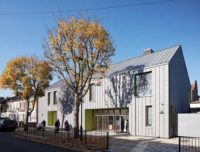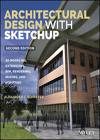NOMA FoodLab by 3XN Architects
Copenhagen, Denmark










Architects & Firms
Using only ingredients sourced from the forests, fields, and waters of the Nordic countries, René Redzepi invented a regional cuisine whose celebration of the local has found a global audience. This year Time magazine named the 34-year-old chef as one of its 100 most influential people, and his Copenhagen restaurant, Noma, was voted Restaurant magazine's best in the world for the third time.
Noma's food is equally strange and sophisticated, earthy and precise—qualities echoed in the design of its new culinary laboratory, the FoodLab. The test kitchen, once in a nearby houseboat, has been relocated to the space above the wharfside restaurant to act as an engine of inspiration. For the interior, Redzepi turned to the architecture firm 3XN, whose office faces Noma across a small harbor. The connection between the two goes beyond mere proximity, however. Kasper Guldager Jørgensen leads 3XN's in-house research-and-development unit, GXN, and made contact with Redzepi after seeing him on TV. The architect was struck by the similarity of their positions: Both lead young, international teams focused on aesthetic and technical innovation. While Noma's chefs draw flavor from bitter roots and unripe fruit, GXN's architects and engineers develop biocomposite cladding and microperforated sunscreens.
For Jørgensen, Noma's “experimentarium” is itself an experimental project that can be applied to 3XN's larger buildings. Though small, it is dense in both ideas and program. In addition to the test kitchen, the 2,153-square-foot FoodLab provides lockers, linen storage, a library, an office, and a staff canteen. To complicate matters, the 18th-century warehouse containing the restaurant and lab is a protected historic structure, so nothing can be fixed to the walls or the eight gnarled pine columns that march in pairs through the center of the space.
GXN's response: to make a series of freestanding installations, at a scale between building and furniture, that serve as both room dividers and shelving. Four cylindrical displays wrap alternate columns. From three, long tails of double-sided storage units extend to the walls, splitting the room roughly into quarters—dining, kitchen, office, and linen storage—that are discrete but not separate.
The architects designed the furniture using parametric-modeling software that allowed for continuous revisions throughout the process and optimized material use. They had all 5,283 components cut from 249 standard 8-by-4-foot sheets of Nordic birch and spruce plywood at a local shop with a CNC milling machine. Then they assembled the pieces themselves on site, in three weeks.
The use of locally produced plywood echoes Redzepi's attitude toward ingredients. The ordinariness of the material is not disguised, but made special by the evident care and intelligence in the design and fabrication process. The shelving is made up of more than 500 open-front boxes, which appear to float independently. Concealed plywood frames allow soft light from integral fixtures to filter through the gaps between boxes, giving the blond wood a warm glow.
The boxes, in various sizes, are arranged in a staggered pattern reminiscent of brickwork, their dimensions derived from the humble plastic containers Noma uses for its spice library. Bearing the names of the exotic produce within them—Icelandic moss, samphire salt, onion ash—these are on display next to decorative artifacts referencing the wild ingredients the chefs forage: blue speckled birds' eggs, razor clams, scallop shells. Elsewhere in the room, nature appears as pixelated birch-tree reliefs carved with a router into the face of the locker doors, and an herb garden in plywood carts, bathed from above in ultraviolet light.
The GXN plan places working areas next to windows, which look out over the harbor, and keeps the wide central aisle free for those passing between areas, or through the lab to one of the restaurant's three service kitchens, where 50 cooks supply just 12 tables. It encourages chance encounters among waiters between shifts, office staff at their desks, and chefs on break, reflecting Redzepi's belief that you get the best results from happy people.
The Danish word hygge, roughly translated as “coziness,” describes a condition whose cultivation is said to be a national obsession. It has both social and material connotations, linking the companionship of family and friends, especially over food, and a physical well-being that comes not from luxury but from low, candlelike light and modest comfort. At the FoodLab, clear plastic “Star” fixtures, designed by the architects, twinkle above the 50-seat canteen. As with the furniture, these were created to embody what Jørgensen calls “Nordic cool” geometry, in which an inner complexity of design and construction is evident in simple forms. A delicate tension also exists between the cool look of the pale, engineered plywood and the warmth of materials like the black lava stone used for the kitchen counters. Chairs, upholstered in a soft, feltlike fabric, help to create an intimate acoustic.
In the dining room downstairs, Redzepi rejected the starched linen tablecloths and cut crystal of Copenhagen's traditional upmarket restaurants in favor of bare, age-scarred walls and understated Danish Modern furniture. It is a carefully contrived design, but one that underscores the food. In the FoodLab, GXN has achieved something similar. The architects have made the plate, not the meal.
PeopleOwner: Noma Architect: GXN (Innovation unit of 3XN Architects) Project Director: Kasper Guldager Jørgensen, Head of GXN Project team: Kim Herforth Nielsen, Kasper Guldager Jørgensen, André van Leth, Lila Held, Morten Norman Lund, Lars-Erik Eriksson, Pedram Seddighzadeh, Matthew Scarlett, Bjørk Christensen, Kyle Baumgardner, Elliot Mistur, Tore Banke, Simon McKenzie and Jacob Hilmer Consultants: Normann Copenhagen (lighting); 1:1 Photographer(s): Adam Mørk |
ProductsMaterials: All done in Nordic wood, for example plywood Kitchen: CPH Square. Contact person Thomas eloy: Thomas@cphsquare.dk Household appliances: Gaggenau. Contact person Anne Herskov: anne.herskov@bshg.com Furniture: GUBI. Contact person Allan Torp: ato@gubi.com Lighting: Normann Copenhagen (STAR Lamp by GXN). Contact person Johanne Toft: johanne@normann-copenhagen.com |






